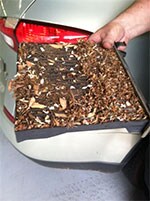
 It
used to be that cars and trucks had separate fresh air intakes that allowed air
to pass directly from the front of the vehicle to the passenger compartment.
It
used to be that cars and trucks had separate fresh air intakes that allowed air
to pass directly from the front of the vehicle to the passenger compartment.
Today,
other than through windows, there is usually only one way for fresh air to
enter your car through the auto ventilation system, which includes the auto air
conditioner. Therefore, all the air that enters your car flows through a
cabin filter and then flows through an evaporator core. When you run
your ventilation system either for heating or cooling, air passes through
the cabin filter and then the evaporator core. When cooling, moisture
from the air is removed by the evaporator core. This moisture accumulates
in the evaporator core chamber where most of it is dumped to the ground through
a drain.
However, some water may still remain. In other words, the chamber and the evaporator can stay wet. Because this area is dark, wet and inevitably dirty, these are ideal breeding conditions for mold and mildew to flourish! When heating, although you have dry conditions. Spores and other fine debris that have accumulated are continually being blown into your enclosed driving environment. In addition, external air carries all kinds of material with it as it enters your vehicle including dust, oil droplets, exhaust vapors, insects, mold spores, pollens and bacteria. This debris accumulates on the evaporator core. Under such conditions, mold and bacteria colonies are nurtured and further contaminate the air in the vehicle.
For these reasons we recommend you change your cabin air filter every 15,000 miles and clean you’re A/C evaporator core every spring and fall of the year.





